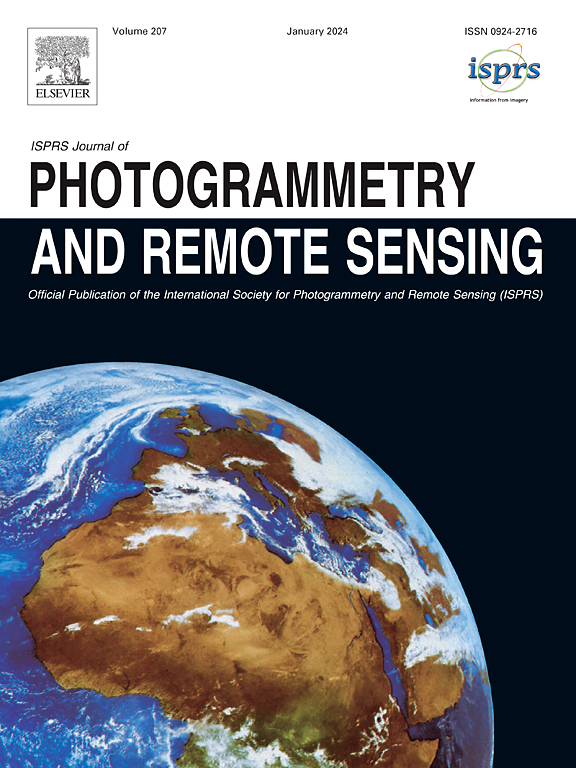PSeqNet: A crop phenology monitoring model accounting for phenological associations
IF 10.6
1区 地球科学
Q1 GEOGRAPHY, PHYSICAL
ISPRS Journal of Photogrammetry and Remote Sensing
Pub Date : 2025-05-05
DOI:10.1016/j.isprsjprs.2025.04.039
引用次数: 0
Abstract
Variations of crop phenology are critical indicators of growth conditions and are essential for scheduling irrigation and fertilization activities to mitigate climate risks. Accurately characterizing carry-over climate impacts and phenological associations, especially the delayed influence of earlier stages development on later stages, is key to understanding crop phenological dynamics under changing climate. However, current remote sensing methods face challenges in matching extracted phenological metrics to crop phenological stages and in exploring complex climate interactions. To address these challenges, we propose a novel data-driven phenology monitoring algorithm named Phenology Seq2Seq Network (PSeqNet) to account for underlying phenological associations using fused remote sensing and meteorological data. A two-stream encoder processes and fuses temporal changes of remotely sensed and meteorological information during the growing season, followed by an autoregressive phenological decoder that utilizes the hierarchical structure of phenological development to learn associations among stages. PSeqNet is applied in Northeastern China as a case study to detect and forecast multiple rice phenological stages at the station level. The results indicate that PSeqNet with a two-stream encoder effectively utilizes fused information and extracts distinct associations among stages through its autoregressive decoder. PSeqNet outperformed generic curve fitting and shape model fitting methods in terms of overall accuracy and the degree of correlation, with overall mean absolute error (MAE) ranging from 3.3 to 4.0 days and correlation coefficient (r) ranging from 0.56 to 0.66. Further analysis highlights that the PSeqNet’s ability to capture unique phenological associations such as the weaker correlation between heading and tillering, and the stronger linear correlation between milking and heading. These distinct associations among stages cannot be adequately characterized by curve-fitting and shape model fitting methods. By utilizing the partial seasonal observations, the PSeqNet model also exhibits an outstanding performance in within-season forecasting in a progressive manner (overall MAE decreased from 4.8 to 4.1 days for maturity). Our findings indicate that the PSeqNet presents a promising approach for representing the phenological associations and provides a flexible approach for integrating multi-source information. This robust phenological monitoring approach holds great potential for identifying crop phenological association patterns and their driving climate factors across broader regions.
PSeqNet:一个考虑物候关联的作物物候监测模型
作物物候变化是生长条件的关键指标,对于灌溉和施肥活动的调度以减轻气候风险至关重要。准确表征气候的携带效应和物候关联,特别是早期发育对后期的延迟影响,是理解气候变化下作物物候动态的关键。然而,目前的遥感方法在将提取的物候指标与作物物候阶段相匹配以及探索复杂的气候相互作用方面面临挑战。为了解决这些挑战,我们提出了一种新的数据驱动的物候监测算法,名为物候Seq2Seq网络(PSeqNet),利用融合的遥感和气象数据来解释潜在的物候关联。一个双流编码器处理和融合生长季节遥感和气象信息的时间变化,然后是一个自回归物候解码器,利用物候发展的层次结构来学习各阶段之间的联系。以东北地区为例,应用PSeqNet在台站水平上对多个水稻物候期进行检测和预测。结果表明,采用双流编码器的PSeqNet有效地利用了融合信息,并通过自回归解码器提取了阶段之间的明显关联。PSeqNet在总体精度和相关程度上优于一般曲线拟合和形状模型拟合方法,总体平均绝对误差(MAE)在3.3 ~ 4.0天之间,相关系数(r)在0.56 ~ 0.66之间。进一步的分析表明,PSeqNet能够捕捉到独特的物候关联,如抽穗和分蘖之间较弱的相关性,以及挤奶和抽穗之间较强的线性相关性。曲线拟合和形状模型拟合方法无法充分表征这些阶段之间的明显关联。通过利用部分季节观测,PSeqNet模型在季内预测中也表现出了出色的渐进式表现(总体MAE从4.8天减少到4.1天)。我们的研究结果表明,PSeqNet提供了一种有前途的方法来表示物候关联,并提供了一种灵活的方法来整合多源信息。这种强大的物候监测方法具有巨大的潜力,可以在更广泛的地区确定作物物候关联模式及其驱动气候因子。
本文章由计算机程序翻译,如有差异,请以英文原文为准。
求助全文
约1分钟内获得全文
求助全文
来源期刊

ISPRS Journal of Photogrammetry and Remote Sensing
工程技术-成像科学与照相技术
CiteScore
21.00
自引率
6.30%
发文量
273
审稿时长
40 days
期刊介绍:
The ISPRS Journal of Photogrammetry and Remote Sensing (P&RS) serves as the official journal of the International Society for Photogrammetry and Remote Sensing (ISPRS). It acts as a platform for scientists and professionals worldwide who are involved in various disciplines that utilize photogrammetry, remote sensing, spatial information systems, computer vision, and related fields. The journal aims to facilitate communication and dissemination of advancements in these disciplines, while also acting as a comprehensive source of reference and archive.
P&RS endeavors to publish high-quality, peer-reviewed research papers that are preferably original and have not been published before. These papers can cover scientific/research, technological development, or application/practical aspects. Additionally, the journal welcomes papers that are based on presentations from ISPRS meetings, as long as they are considered significant contributions to the aforementioned fields.
In particular, P&RS encourages the submission of papers that are of broad scientific interest, showcase innovative applications (especially in emerging fields), have an interdisciplinary focus, discuss topics that have received limited attention in P&RS or related journals, or explore new directions in scientific or professional realms. It is preferred that theoretical papers include practical applications, while papers focusing on systems and applications should include a theoretical background.
 求助内容:
求助内容: 应助结果提醒方式:
应助结果提醒方式:


